Oxygen Therapy ATI – Flashcards
Unlock all answers in this set
Unlock answersquestion
atelectasis
answer
airlessness or collapse of a lung, usually as a result of hypoventilation or obstruction
question
bi-level positive airway pressure (BiPAP)
answer
a noninvasive, ventilation-assistance modality that provides higher airway pressure during inspiration and lower pressure during expiration, usually delivered by a face mask
question
continuous positive airway pressure (CPAP)
answer
a noninvasive, ventilation-assistance modality that provides a set positive airway pressure throughout the patient's respiratory cycle
question
cyanosis
answer
a bluish discoloration, especially of the skin and mucous membranes, due to excessive concentration of deoxyhemoglobin (hemoglobin not combined with oxygen) in the blood
question
dyspnea
answer
difficult or labored breathing
question
face tent
answer
a soft, oxygen-delivery mask that fits under the patient's chin, loosely covers the mouth and nose, and is held in place by an adjustable elastic strap
question
flow meter
answer
a device used to control the rate of oxygen being delivered in liters per minute
question
flow rate
answer
the quantity of oxygen delivered in liters per minute
question
fraction of inspired oxygen (FiO2)
answer
the oxygen level inhaled by or delivered to the patient, expressed in a percentage of atmospheric air
question
hypercapnia
answer
an excess of carbon dioxide in the blood
question
hypoxemia
answer
a diminished amount (reduced saturation) of oxygen in arterial blood
question
hypoxia
answer
a reduced supply of oxygen to tissues below physiological levels despite adequate perfusion of the tissue by blood
question
incentive spirometer
answer
a resistive breathing device that helps patients exercise their breathing muscles, provides visual reference for deep breathing; educate patient: 1. exhale normally 2. place spirometer in mouth 3. inhale as deeply as possible through mouth & hold breath to count of 3 4. remove mouth from spirometer and exhale normally 5. perform 10x/ hour
question
manual resuscitation bag
answer
a hand-held device consisting of a flexible air chamber attached to a face mask via a shutter valve and used to provide ventilation to a patient who is not breathing or who is breathing inadequately; often referred to by the common brand name, Ambu bag
question
mechanical ventilator
answer
breathing assistance provided by a ventilator, one of various types of devices that support and maintain respiratory function
question
naris
answer
one of the two external orifices of the nose; nostril (plural: nares)
question
noninvasive ventilation
answer
a type of breathing assistance used to maintain positive airway pressure and improve alveolar ventilation without the need for an artificial airway
question
oxygen
answer
a tasteless, odorless gas that comprises 21% of atmospheric air and is used by the body to maintain adequate cellular function
question
oxygen mask
answer
a device that fits over the patient's nose and mouth and delivers oxygen, humidity, and/or heated humidity
question
oxygen tent
answer
a canopy that surrounds the patient, providing oxygen, humidification, and a cool environment to help control body temperature
question
oxygen therapy
answer
the delivery of oxygen for therapeutic purposes
question
partial nonrebreather mask
answer
an oxygen-delivery apparatus similar to a nonrebreather mask, but with a two-way valve allowing the patient to rebreathe exhaled air
question
positive-pressure ventilation
answer
a technique that uses a mechanism such as a mechanical ventilator to force air into the lungs to provide breathing assistance
question
pulse oximeter
answer
a noninvasive device that measures oxygen saturation indirectly via a finger or ear probe with a light-emitting diode (LED) and a photo detector attached by a cable to the device
question
pulse oximetry
answer
the measurement of oxygen saturation indirectly via a finger or ear probe with a light-emitting diode (LED) and a photo detector attached by a cable to the oximeter device
question
simple face mask
answer
an oxygen-delivery apparatus used for patients who require a moderate flow rate for a short period of time via a plastic mask that fits snugly over the mouth and nose
question
t-tube
answer
a t-shaped conduit with a piece that connects an oxygen source to the patient's artificial airway
question
tidal volume
answer
the amount of air normally breathed in and out with each respiratory cycle either spontaneously or delivered via mechanical ventilation
question
tracheostomy
answer
an opening created by a surgical incision into the trachea for the purpose of establishing and maintaining an airway
question
tracheostomy collar
answer
a small oxygen-delivery apparatus that fits over a tracheostomy site and is held in place by an adjustable elastic strap that fits around the patient's neck; also called a tracheostomy mask
question
tracheostomy mask
answer
a small oxygen-delivery apparatus that fits over a tracheostomy site and is held in place by an adjustable elastic strap that fits around the patient's neck; also called a tracheostomy collar
question
ventilation
answer
inspiration and expiration, the process of the exchange of air between the lungs and the environment
question
compliance
answer
stretchability
question
airway resistance
answer
how hard it is to pull air into lungs
question
Ventilation is stimulated by....
answer
increased CO2 in arterial blood (PaCO2) stimulates inspiration, decreased PaO2 also influences inspiration to a lesser degree.
question
diffusion
answer
movement of O2 and CO2 between alveoli and capillaries (from higher pressure to lower pressure)
question
perfusion
answer
delivery of oxygenated blood to body tissues
question
O2 Transport affected by:
answer
1. the amount of O2 entering lungs (ventilation) 2. pulmonary circulation 3. adequacy of diffusion 4. amount of hemoglobin to carry O2 5. cardiac output to transport blood to body tissues 6. peripheral circulation
question
Problems with ventilation, diffusion, or perfusion lead to...
answer
hypoxia.
question
acute hypoxia
answer
a sudden difficulty breathing; leading to symptoms such as anxiety, restlessness, dyspnea, high BP, small pulse pressure, pallor, cyanosis
question
chronic hypoxia
answer
someone used to living with lower oxygen levels, see long term affects i.e.clubbing, decreased urinary output, systemic issues
question
CO=
answer
SV X HR
question
cardiac output is affected by...
answer
1. preload (volume) 2. afterload (resistance) 3. myocardial contractility
question
The primary purpose of surfactant is A. to propel sheet of mucus toward the upper airway B. to warm inspired air C. to produce watery mucous D. to reduce surface tension of the fluid lining of the alveoli
answer
D (often an issue for premature babies)
question
birth
answer
have to switch to breathing air
question
infants
answer
small chests, short airways; breath much more rapidly then later on
question
pre-school/ school-age
answer
lots of upper respiratory infections
question
older adult
answer
decreased muscle tone leading to more difficulty using muscles, sometimes see kyphosis, at risk for respiratory disease
question
COPD
answer
Chronic Obstructive Pulmonary Disease; drive to breathe shifts, depends on oxygen levels not CO2
question
emphysema
answer
a disease that progressively destroys the walls of the alveoli
question
Abdominal breathing at 30-60 breaths/min with an irregular pattern of rate and depth would closely describe the breathing pattern of what age group? A. Older adult B. Infant C. Children D. Adolescents
answer
B (nervous system isn't mature)
question
A patient with a fractured rib is breathing less often and with less depth because of the pain. The nurse would document this finding using which term? A. fremitus B. hyperventilation C. pleural friction rub D. hypoventilation
answer
D
question
A patient who has difficulty breathing, increased respiratory and pulse rates, and pale skin with some cyanosis may be suffering from which of the following? A. hyperventilation B. hypoxia C. perfusion D. atelectasis
answer
D (acute)
question
The nurse assesses an adult patient's SpO2 as 82%. The nurse would expect to see which of the following assessment findings? A. cyanosis B. capillary refill < 2 sec. C. unlabored breathing D. respiratory rate 16 breath/min.
answer
A
question
Pulse Oximetry
answer
Measures amount of Hgb saturated with O2 in arterial blood (SaO2 or Sp02)
question
Examples of Nursing Diagnoses:
answer
1. ineffective Airway Clearance r/t secretions 2. impaired Gas Exchange r/t history of smoking 3. ineffective Breathing Pattern r/t anxiety 4. acute pain r/t pleural inflammation 5. acute confusion r/t impaired ventilation 6. anxiety r/t feeling of suffocation 7. fatigue r/t impaired oxygen transport 8. disturbed sleep pattern r/t orthopnea
question
Examples of Nursing Interventions:
answer
1. promoting Comfort (patient positioning, hydration) 2. patient Education (breathing exercise i.e. deep breathing, pursed lip breathing, diaphragmatic breathing; incentive spirometry) 3. chest PT & Postural Drainage 4. administering Medications 5. administration of Oxygen
question
normal SpO2=
answer
95-100% (<85%= inadequate tissue oxygenation)
question
pursed lip breathing
answer
to gain control of rate & depth of respiration, goal is to prolong exhalation; educate to patient: 1. sit or stand upright 2. onhale through nose- count to 3 3. exhale through pursed lips, tighten abdomen- count to 7
question
diaphragmatic breathing
answer
Used for COPD patients who breathe shallow, rapid breaths- exhausting! Reduces respiratory rate, increases tidal volume, reduces functional residual capacity Educate patient: Place one hand on stomach & one hand on middle of chest Inhale slowly through nose while protruding abdomen Exhale through pursed lips while contracting abdominal muscles press in and up on abdomen Perform x 1 min followed by 2 min rest Practice several times/day so eventually becomes automatic
question
chest physiotherapy (CPT)
answer
percussion and vibration
question
percussion
answer
sounds like a horse clopping, cupping motion on back of lungs
question
vibration
answer
Use rhythmic contraction and relaxation of arm and shoulder muscles while holding hands flat on chest wall as patient exhales
question
postural drainage
answer
force of gravity assists drainage of secretions
question
bronchodilators
answer
open up bronchioles
question
mucolytics
answer
thin out secretions
question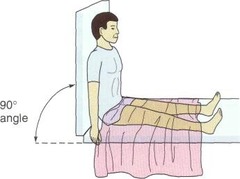
A patient with dyspnea should be placed in which of the following positions? A. prone B. lateral C. supine D. Fowler's

answer
D
question
Mr. Parks has COPD. The nurse has taught him that pursed-lip breathing helps him by A. increasing carbon dioxide, which stimulates breathing. B. prolonging inspiration and shortening expiration. C. liquefying his secretions. D. decreasing the amount of air trapping and resistance.
answer
D
question
Effective use of a metered-dose inhaler requires the patient to do which of the following? A. Breathe in through nose B. Inhale 2 sprays with 1 breath C. Hold breath for 5-10 seconds after inspiration D. Exhale quickly through open mouth
answer
C
question
To drain the apical section of the upper lobes of the lungs, the nurse should place the patient in which position? A. left side with a pillow under the chest wall B. side-lying, half on abdomen and half on side C. High Fowler's D. Trendelenberg
answer
C
question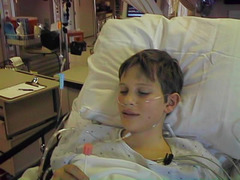
nasal cannula

answer
1-6 L/min, a common oxygen-delivery device consisting of a length of tubing with two small prongs that are inserted into the patient's nares
question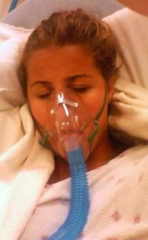
simple mask

answer
6-12 L/min
question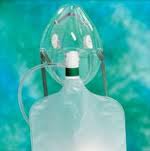
partial rebreather mask

answer
6-15 L/min
question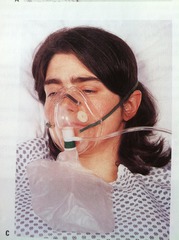
nonrebreather mask

answer
highest concentration of O2, 6-15 L/min, an oxygen-delivery apparatus used to deliver high flow rates and high concentrations of oxygen via a mask that fits snugly over the patient's mouth and nose
question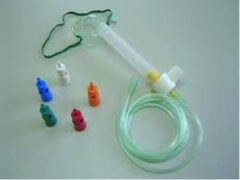
venturi mask

answer
an oxygen-delivery apparatus consisting of a mask with holes on each side that allow exhaled air to escape and color-coded entrainment ports that are adjustable to allow regulation of the concentration of oxygen delivered, MOST PRECISE, 4-10 L/min (24%-55% FiO2)
question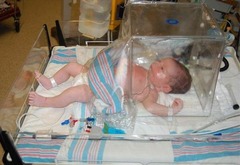
oxygen tents

answer
provides cool, highly humidified airflow
question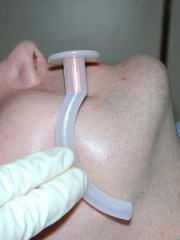
oropharyngeal airways

answer
when muscles relax, tongue falls back and occludes the airway, used to keep tongue clear of airway, used during recovery from anesthesia, comatose patients, to prevent biting ET tubes; do not tape airway in place- patient should be able to spit it out when alert
question
Which oxygen delivery device would the nurse expect to use to provide the highest concentration of oxygen to a patient who is breathing spontaneously? A. partial rebreather mask B. nonrebreather mask C. simple mask D. venturi mask
answer
B
question
When planning care for a patient with chronic lung disease (COPD) who is receiving oxygen through a nasal cannula, the nurse expects that A. the oxygen must be humidified B. the rate will be 2 L/min or less C. arterial blood gases will be drawn every 4 hours to assess flow rate D. the rate will be 6 L/min or more
answer
B
question
David White is in the hospital with a medical diagnosis of viral pneumonia. He is receiving oxygen through a simple face mask. The nurse ensure that the mask fits snugly over the patient's face for which reason? A. To prevent mask movement and consequent skin breakdown B. To help the patient feel secure C. To maintain carbon dioxide retention D. To aid in maintaining expected oxygen delivery
answer
D
question
To prevent a common complications of continuous enternal tube feedings ,a nurse should
answer
limit the time the formula hangs to 4hr (if it hangs longer it is at risk fro bacterial contamination)
question
A nurse inserting a nasogastric tube asks the patient to flex her head toward her chest after the tube passes through the nasopharynx. This action facilitates proper insertion of the tube by
answer
closing off the glottis
question
To prevent aspiration during the administration of an enternal tube feeding, a nurse should
answer
place the patient in fowlers position
question
A patient with a gastric ileus postoperatively requires nutritional support for approximately 2 weeks. Which of the following types of feeding tubes is appropriate for this patient
answer
Nasointestinal tube
question
To determine how much of the length of a nasogastric tube to insert, a nurse should measure the distance from the tip of the patients nose to the earlobe to the
answer
xiphoid process plus 20 to 30 cm more
question
Which of the following formulas is appropriate to administer to a patient who has dysfunctional gastrointestinal tract
answer
elemental
question
An older adult patient in a long term care facility is receiving intermittent enternal feedings in his room. His affect is flat, and the nurse suspects that he is feeling isolated. which of the following interventions is appropriate for this patient
answer
Encourage him to go to the dining room at meal times to talk with other patients
question
The most reliable method for verifying initial placement of a small-bore feeding tube is by
answer
obtaining an abdominal x-ray
question
A nurse is providing teaching to a patient who is receiving intermittent nasogastric feedings. Which of the following should the nurse instruct the patient to report immediately
answer
persistant coughing
question
A nurse is caring fro a patient who has a tracheostromy. Which of the following must the nurse use when administering oxygen to the patient
answer
tracheostomy collar
question
A nurse is caring for a patient who is dyspenic and slightly cyanotic, with a respiratory rate of 28/min. The nurse determines that the patient has impaired gas exchange during which of the following phases of the nursing process
answer
diagnosis
question
A nurse should recognize that which of the following is an indication fro oxygen therapy
answer
Tachypnea; SaO2 90%
question
A nurse is caring for a critically ill patient with COPD who requires delivery of a precise concentration of oxygen. Which of the following types of oxygen-delivery device is indicated fro this patient
answer
venturi mask
question
A home health nurse is instruction a patient who has just started receiving oxygen therapy via mask. The nurse should emphasize that the patient must
answer
reposition the elastic band frequently
question
A patient has been receiving oxygen PRN via nasal cannula fro 4 hr. Which of the following assessment findings helps indicate that oxygen therapy has been effective
answer
Respiratory rate 14/min
question
A patient admitted with community-acquired pneumonia has been receiving oxygen therapy for several days. Which of the following assessment findings indicates an adverse effect of oxygen therapy
answer
cracks in the oral mucosa
question
Administering oxygen therapy with a nonbreather mask has which of the following advantages
answer
offers the highest oxygen concentration of the low-flow systems
question
A patient who is prescribed oxygen therapy 24hr/day is concerned about being confined to bed. Which of the following would the nurse do to provide mobility fro this patient
answer
make sure the patient has up to 50ft of connection tubing
question
Oxygen therapy is prescribed fro a patient who is brought to an emergency department in the early stages of hypoxia. When assessing this patient, the nurse should expect to find which of the following clinical indicators
answer
elevated blood pressure
question
A nurse is providing discharge teaching to a patient who will continue oxygen therapy at home. The nurse should instruct the patient that turning the knob on the oxygen flow meter all the way to the right
answer
stops the oxygen flow
question
Nasogastric tube feedings are an appropriate choice for patients who
answer
is postoperative following laryngectomy
question
A nurse should recognize that nasogastric intubation is indicated to relieve gastric distention for which patient
answer
40 year old patient w/ a postoperative bowel obstruction
question
A nurse is caring for a patient who has a newly inserted nasogastric tube. Which method is appropriate for verifying the initial placement
answer
X-Ray examination of the chest and abdomen (it's the gold standard)
question
A nurse is performing a nasogastric intubation. Which of the following actions should the nurse take immediately after inserting the tube to the predetermined length
answer
Inspect the oropharynx with a penlight and a tongue blade
question
During report, a nurse is informed that a patient has a nasogastric tube connected to continuous suction. The nurse should recognize that this patient must have which types of tube
answer
Salem sump
question
A patient recovering from gastric surgery remains NPO and has a nasogastric tube connected to suction. Which of the following actions should the nurse take to prevent dry mucous membranes
answer
Provide frequent mouth care
question
What should not be used for a patient who is NPO status and just underwent gastric surgery
answer
Throat lozenges
question
When using chilled normal saline solution during gastric lavage, nurse should watch for which of the following complications
answer
Hypothermia
question
Iced normal saline can cause a rapid loss of what
answer
Electrolytes
question
A nurse is caring for an unconscious patient. Which of the following statements by the nurse indicates an understanding of providing good oral hygiene for the patient
answer
"I'll swab the patient's mouth with diluted hydrogen peroxide."
question
What is not appropriate for oral hygiene for a patient that removes moisture from the oral cavity and that damages tooth enamel
answer
Lemon-glycerin swabs
question
When planning morning hygiene care for a postoperative patient, which of the following actions should the nurse include
answer
Ask the patient in what order she typically performs her morning routine
question
A nurse is caring for an adult patient who is NPO. The patient is refusing oral care. Which of the following is appropriate by the nurse
answer
"Oral care is still important even though you are not eating."
question
Why is it important to perform oral care
answer
To help reduce oral bacteria and keep the oral cavity moist
question
A nurse is caring for a patient who is on long-term bed rest and requires frequent linen changes due to excess diaphoresis. Which of the following is the priority rationale for frequent linen changes
answer
Moisture from excessive diaphoresis can cause skin breakdown
question
A nurse observes an assistive personnel (AP) make a client's bed while the client is out of the room. Which of the following actions by the AP is appropriate for this task
answer
The AP reuses the patient's blanket and spread
question
Making a clients bed does not require what
answer
Documentation
question
While performing a complete bed bath for a patient, the nurse should
answer
Raise the room temperature
question
Why should soap not be added to the water in the basin when giving a bed bath
answer
Irritation to the eyes can occur
question
What is the nurse going to do when giving a patient a tub bath
answer
First, nurse will gather all necessary supplies. Second, prepare the room by placing a rubber mat on the rub floor to prevent the patient from slipping and falling. Third, nurse will assist patient into the bathroom and give instructions regarding the use of bars to prevent slipping and falling when entering or exiting the bathtub. Lastly, nurse will instruct patient to remain in tub for no longer than 20 min due to possibility of vasodilation from warm water, which can cause light-headedness or dizziness.
question
A nurse is assisting a patient with personal hygiene care. Which of the following actions by the nurse will reduce the risk of infection
answer
Cleaning the lease-soiled areas prior to cleaning the most-soiled areas
question
How should a bed bath be given
answer
Using long, firm strokes and proceeding from the distal to the proximal areas
question
A nurse is caring for a patient who has impaired swallowing due to a cerebralvascular accident. Which of the following interventions should the nurse use to assist the patient with feeding
answer
elevate the head of the bed 45 to 90 degrees
question
A nurse should recognize that which of the following is correct regarding albumin levels as a diagnostic marker for nutritional status
answer
Albumin level is a poor short-term indicator poor short-term indicator of protein status
question
Which of the following strategies for enhancing the intake of healthful foods is appropriate for an adolescent
answer
Making healthful food choices more convenient and available for the adolescent
question
Which of the following is appropriate fro a full liquid diet
answer
plain yogurt, custard, pureed vegetables, gelatin
question
A nurse caring for a patient who has sustained a head injury and whose level of consciousness fluctuates. The provider prescribes a full liquid diet progressing to a pureed diet as tolerated. Before initiating feedings, it is essential that this patient undergo which of following
answer
swallowing exam
question
When teaching the parents of a toddler about feeding and eating, the nurse should include which of the following safety measures
answer
do not offer the child raw vegetables
question
A nurse is performing a nutritional assessment. When obtaining and interpreting anthropometric values, the nurse should recognize which of the following
answer
the patient should be weighed on that same scale at the same time each day
question
To assess a patient fro adequate swallowing, the nurse should do which of the following-
answer
Place the fingers on the patients throat at the level of the larynx and ask him to swallow
question
Which of the following interventions should a nurse use at mealtimes for a patient who has visual deficits
answer
identify the food location as though the plate were a clock
question
Which of the following dietary modifications should an adolescent engaging in sports implement
answer
drink water before and after sports activates
question
Which of the following is the primary purpose fro asking a patient to keep a 3-7 day food diary
answer
to assess the pattern of intake and compare with daily reference intakes
question
Which of the following techniques is appropriate when obtaining a blood pressure on a child
answer
Use a cuff with bladder covering 80 to 100% of the arm circumference
question
Which of the following communication techniques is most appropriate fro a nurse to employ during the physical examination of a 10 year ol
answer
Use books and other visual aids to advance the interview
question
A nurse is testing a child for strabismus. Which of the following is the correct technique fro performing this examination
answer
perform the cover-uncover test
question
When performing an otoscopy examination on a 2-year old child, the nurse should pull the pinna
answer
down and back
question
A nurse is performing an abortion examination on a preschooler. Which of the following instructions should the nurse give to the child when performing abdominal palpitation
answer
place your hand under mine
question
A nurse is performing an annual physical examination on an adolescent. Which of the following should be included in the general survey
answer
the patient makes good eye contact
question
When assessing a school age child for scoliosis, it is important to have the child
answer
bend forward with the knees straight and the arms dangling
question
A nurse is examining an 18-month-old child ears during a well child visit. Which of the following techniques should the nurse use
answer
have the parent hold the child securely in their lap
question
A nurse is documenting findings from a physical examination. Which of the following statements indicates correct charting
answer
Regular heart rate and rhythm: S1, S2 heard.
question
A nurse is obtaining a problem-oriented history from a preschool-aged child. The nurse should consider that children form this age group typically can
answer
describe the symptoms
question
latex and latex free equipment
answer
main source of concern with regards to medical equipment because a large majority contains latex material. Client should be assessed for latex allergy during initial assessment
question
hand hygeine
answer
hand hygeine refers to both the actual process of washing the hands with soap and water as well as the use of an antimicrobial agent. The use of antimicrobial agent is acceptable except when the hands are visibly soiled or coming into contact with specific bateria's that could potentially become harmful
question
waste managment
answer
handle sharps and dispose of them in a "sharps container"; dispose of blood or bodily fluids in the agencies "flush system"; and always transport linen in a closed liquid-containable bag NEVER A KNIT OR DRAWSTRING BACK THAT COULD SPREAD BODILY FLUID
question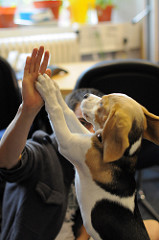
proper cough etiquette involves what 5 things...

answer
1. covering mouth and nose during coughing or sneezing 2. wear a surgical mask when coughing 3. using facial tissues to contain secretions 4. turn the head when coughing away from others atleast 3 feet 5. disinfecting hands after sneezing or coughing
question
a nurse preparing a sterile field knows that the field has been contaminated when
answer
1. a cotton ball dampened with normal saline touches the field 2. the nurse turns to answer the clients question 3. the procedure is post poned for 30min
question
when opening a sterile pack, which of the following would compromise sterility
answer
holding the sterile contents below the waist when opening



